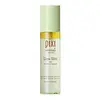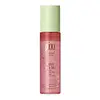What's inside
What's inside
 Key Ingredients
Key Ingredients

 Benefits
Benefits

 Concerns
Concerns

 Ingredients Side-by-side
Ingredients Side-by-side

Water
Skin ConditioningOlea Europaea Fruit Oil
MaskingDipropylene Glycol
HumectantButylene Glycol
HumectantPropolis Extract
Skin ConditioningNiacinamide
SmoothingArgania Spinosa Kernel Oil
EmollientAloe Barbadensis Leaf Extract
EmollientBetaine
HumectantSodium Hyaluronate
HumectantPEG/PPG-17/6 Copolymer
SolventPanthenol
Skin ConditioningCarthamus Tinctorius Seed Oil
MaskingPersea Gratissima Oil
Skin ConditioningOenothera Biennis Oil
EmollientRosa Canina Fruit Oil
EmollientSimmondsia Chinensis Seed Oil
EmollientMacadamia Integrifolia Seed Oil
Skin Conditioning1,2-Hexanediol
Skin ConditioningCaprylyl Glycol
EmollientIllicium Verum Fruit Extract
PerfumingAdenosine
Skin ConditioningRose Flower Oil
MaskingTagetes Minuta Flower Oil
MaskingMentha Arvensis Leaf Oil
MaskingElettaria Cardamomum Seed Oil
MaskingThymus Vulgaris Oil
MaskingEugenia Caryophyllus Leaf Oil
MaskingMelaleuca Alternifolia Leaf Oil
AntioxidantVetiveria Zizanoides Root Oil
MaskingCymbopogon Schoenanthus Oil
MaskingPelargonium Graveolens Flower Oil
MaskingLavandula Angustifolia Oil
MaskingCitrus Limon Peel Oil
MaskingCitrus Aurantium Dulcis Peel Oil
MaskingWater, Olea Europaea Fruit Oil, Dipropylene Glycol, Butylene Glycol, Propolis Extract, Niacinamide, Argania Spinosa Kernel Oil, Aloe Barbadensis Leaf Extract, Betaine, Sodium Hyaluronate, PEG/PPG-17/6 Copolymer, Panthenol, Carthamus Tinctorius Seed Oil, Persea Gratissima Oil, Oenothera Biennis Oil, Rosa Canina Fruit Oil, Simmondsia Chinensis Seed Oil, Macadamia Integrifolia Seed Oil, 1,2-Hexanediol, Caprylyl Glycol, Illicium Verum Fruit Extract, Adenosine, Rose Flower Oil, Tagetes Minuta Flower Oil, Mentha Arvensis Leaf Oil, Elettaria Cardamomum Seed Oil, Thymus Vulgaris Oil, Eugenia Caryophyllus Leaf Oil, Melaleuca Alternifolia Leaf Oil, Vetiveria Zizanoides Root Oil, Cymbopogon Schoenanthus Oil, Pelargonium Graveolens Flower Oil, Lavandula Angustifolia Oil, Citrus Limon Peel Oil, Citrus Aurantium Dulcis Peel Oil
Water
Skin ConditioningOlea Europaea Fruit Oil
MaskingGlycerin
HumectantDipropylene Glycol
HumectantButylene Glycol
HumectantArgania Spinosa Kernel Oil
EmollientCaprylyl Glycol
Emollient1,2-Hexanediol
Skin ConditioningCarthamus Tinctorius Seed Oil
MaskingBetaine
HumectantPersea Gratissima Oil
Skin ConditioningIllicium Verum Fruit Extract
PerfumingTrehalose
HumectantPanthenol
Skin ConditioningEclipta Prostrata Extract
Skin ConditioningArtemisia Absinthium Extract
Skin ConditioningArnica Montana Flower Extract
MaskingAchillea Millefolium Extract
CleansingViola Mandshurica Flower Extract
AntioxidantHibiscus Esculentus Fruit Extract
Skin ConditioningAloe Barbadensis Leaf Extract
EmollientGentiana Lutea Root Extract
Skin ConditioningPelargonium Graveolens Flower Oil
MaskingCymbopogon Martini Oil
MaskingMelia Azadirachta Leaf Extract
Skin ConditioningVegetable Oil
Skin ConditioningCananga Odorata Flower Oil
MaskingRosa Damascena Flower Oil
MaskingCitrus Aurantium Bergamia Peel Oil
Propylene Glycol
HumectantMoringa Oleifera Seed Oil
EmollientTocopherol
AntioxidantWater, Olea Europaea Fruit Oil, Glycerin, Dipropylene Glycol, Butylene Glycol, Argania Spinosa Kernel Oil, Caprylyl Glycol, 1,2-Hexanediol, Carthamus Tinctorius Seed Oil, Betaine, Persea Gratissima Oil, Illicium Verum Fruit Extract, Trehalose, Panthenol, Eclipta Prostrata Extract, Artemisia Absinthium Extract, Arnica Montana Flower Extract, Achillea Millefolium Extract, Viola Mandshurica Flower Extract, Hibiscus Esculentus Fruit Extract, Aloe Barbadensis Leaf Extract, Gentiana Lutea Root Extract, Pelargonium Graveolens Flower Oil, Cymbopogon Martini Oil, Melia Azadirachta Leaf Extract, Vegetable Oil, Cananga Odorata Flower Oil, Rosa Damascena Flower Oil, Citrus Aurantium Bergamia Peel Oil, Propylene Glycol, Moringa Oleifera Seed Oil, Tocopherol
 Reviews
Reviews

Ingredients Explained
These ingredients are found in both products.
Ingredients higher up in an ingredient list are typically present in a larger amount.
1,2-Hexanediol is a synthetic liquid and another multi-functional powerhouse.
It is a:
- Humectant, drawing moisture into the skin
- Emollient, helping to soften skin
- Solvent, dispersing and stabilizing formulas
- Preservative booster, enhancing the antimicrobial activity of other preservatives
Aloe Barbadensis Leaf Extract is an extract of the leaves of the aloe, Aloe barbadensis, Liliaceae.
Aloe is one of the most well-known natural soothing ingredients, and for good reason. It’s full of water and has a cooling, calming effect on the skin, especially when it’s sunburned, itchy, or irritated. Aloe also helps your skin stay hydrated and smooth by mimicking what healthy skin naturally produces. On top of that, it contains vitamins and nutrients that support skin recovery.
It doesn’t protect you from the sun, but it can help your skin bounce back after too much time in it.
Let’s get into the details:
Aloe contains antioxidant Vitamins A, C, and E, which help fight off free radicals (unstable molecules from things like pollution that can damage your skin).
It’s also rich in polysaccharides, which are natural sugars that help hydrate the skin by acting like the skin’s own moisturizing agents. These, along with other sugars like monosaccharides, help form a protective barrier that locks in moisture.
Aloe works as both a humectant and an emollient. That means it draws water into the skin (humectant) and helps trap it there (emollient), making it an effective natural moisturizer.
You’ll also find a mix of other skin-supporting ingredients in aloe, including folic acid, choline, calcium, amino acids, fatty acids, and even Vitamin B12.
Out of the 420+ species of aloe, Aloe barbadensis is the most widely used in skincare products thanks to its gentle yet effective properties.
There are over 420 species of aloe but Aloe Barbadensis is the most commonly used for topical products.
Learn more about Aloe Barbadensis Leaf ExtractYou may know this ingredient as argan oil. Argan Oil has antioxidant, hydrating, and soothing properties.
Studies have shown argan oil can help fight again radical damage from the sun. This makes it effective at preventing hyperpigmentation.
Large amounts of vitamin E found in argan oil helps the skin retain water. Argan oil also contains fatty acids such as linoleic acid, oleic acid, and palmitic acid. It is also a good source of lipids.
Another benefit of argan oil is skin-soothing. It can help reduce inflammation-related skin symptoms.
Argan Oil is effective at regulating sebum production in pores. This can make it effective at treating hormonal acne.
Traditionally, argan oil was used for its antibacterial and antifungal properties. However, argan oil contains fatty acids that may make it not fungal-acne safe.
Argan Trees are native to Morocco.
Learn more about Argania Spinosa Kernel OilBetaine is a common humectant (a substance that promotes retention of moisture). It's known to be gentle on the skin and can help balance hydration.
This ingredient is best for improving hydration and soothing irritated skin. Studies also show it helps even out skin tone.
Fun fact: Betaine is naturally created in the skin and body. The kind found within cosmetic products can be either plant-derived or synthetic.
Another name for betaine is trimethylglycine.
Learn more about BetaineButylene Glycol (or BG) is used within cosmetic products for a few different reasons:
Overall, Butylene Glycol is a safe and well-rounded ingredient that works well with other ingredients.
Though this ingredient works well with most skin types, some people with sensitive skin may experience a reaction such as allergic rashes, closed comedones, or itchiness.
Learn more about Butylene GlycolCaprylyl Glycol is a humectant and emollient, meaning it attracts and preserves moisture.
It is a common ingredient in many products, especially those designed to hydrate skin. The primary benefits are retaining moisture, skin softening, and promoting a healthy skin barrier.
Though Caprylyl Glycol is an alcohol derived from fatty acids, it is not the kind that can dry out skin.
This ingredient is also used as a preservative to extend the life of products. It has slight antimicrobial properties.
Learn more about Caprylyl GlycolCarthamus tinctorius seed oil comes from safflower, one of humanity's oldest crops.
Safflower seed oil contains a high percentage of linoleic acid and oleic acid. It also contains Vitamin E. These three components are effective moisturizers.
Vitamin E helps nourish your skin's lipid barrier. It is also a potent antioxidant. Antioxidants help fight free-radical molecules, or unstable molecules that may damage your skin cells.
Due to its high fatty acid content, this ingredient may not be malassezia folliculitis safe.
Thoughout history, safflower has been used for dying fabrics and in food as a saffron substitute.
Learn more about Carthamus Tinctorius Seed OilDipropylene Glycol is a synthetically created humectant, stabilizer, and solvent.
This ingredient helps:
Dipropylene glycol is technically an alcohol, but it belongs to the glycol family (often considered part of the ‘good’ alcohols). This means it is hydrating and gentle on skin unlike drying solvent alcohols like denatured alcohol.
As a masking agent, Dipropylene Glycol can be used to cover the smell of other ingredients. However, it does not have a scent.
Studies show Dipropylene Glycol is considered safe to use in skincare.
Learn more about Dipropylene GlycolStar anise extract is used to add a scent to a product. It has a similar smell to black licorice.
Olea Europaea Fruit Oil is the fixed oil obtained from the ripe fruit of the Olive. In other words - olive oil.
The primary contents of olive oil are glycerides of the fatty acids linoleic, oleic and palmitic.
Olive oil also contains antioxidants such as Vitamin E. Antioxidants may help reduce signs of aging by fighting unstable free-radical molecules. It also contains Vitamins A (retinol), D, and K.
The squalene in olive oil makes it a great emollient. Emollients help soothe and soften your skin by trapping moisture in. This makes olive oil a great skin moisturizer.
Studies show olive oil to have antibacterial and antifungal properties in low concentrations. Another study found olive oil irritated sensitive oily skin. We always recommend speaking with a professional about using this ingredient in your routine.
Due to the fatty acid content, this ingredient may not be fungal-acne safe.
Learn more about Olea Europaea Fruit OilPanthenol is a common ingredient that helps hydrate and soothe the skin. It is found naturally in our skin and hair.
There are two forms of panthenol: D and L.
D-panthenol is also known as dexpanthenol. Most cosmetics use dexpanthenol or a mixture of D and L-panthenol.
Panthenol is famous due to its ability to go deeper into the skin's layers. Using this ingredient has numerous pros (and no cons):
Like hyaluronic acid, panthenol is a humectant. Humectants are able to bind and hold large amounts of water to keep skin hydrated.
This ingredient works well for wound healing. It works by increasing tissue in the wound and helps close open wounds.
Once oxidized, panthenol converts to pantothenic acid. Panthothenic acid is found in all living cells.
This ingredient is also referred to as pro-vitamin B5.
Learn more about PanthenolPelargonium Graveolens Flower Oil is the pressed oil of the Rose Geranium plant. It is volatile, meaning it evaporates off the skin.
Fragrant components of Rose Geranium include citronellol and geraniol. These may cause allergies and skin-sensitivity. We recommend speaking with a professional if you have any concerns.
The scent of Rose Geranium closely resembles traditional roses.
Learn more about Pelargonium Graveolens Flower OilPersea Gratissima Oil is also known as avocado oil.
Avocado Oil has antioxidant properties. It is mostly made up of the glycerides of fatty acids. About 67% of these fatty acids is made up of oleic acid. Palmitic acid and linoleic acid are also present.
These fatty acids help hydrate and soften the skin. It may increase collagen content in the skin. Collagen helps keep your skin plump and firm. This ingredient helps reduce inflammation and has not shown to clog pores.
This ingredient may not be fungal-acne safe due to its high fatty acid content.
Avocados also have B vitamins, vitamin K, vitamin C, vitamin E, and potassium.
Learn more about Persea Gratissima OilWater. It's the most common cosmetic ingredient of all. You'll usually see it at the top of ingredient lists, meaning that it makes up the largest part of the product.
So why is it so popular? Water most often acts as a solvent - this means that it helps dissolve other ingredients into the formulation.
You'll also recognize water as that liquid we all need to stay alive. If you see this, drink a glass of water. Stay hydrated!
Learn more about Water